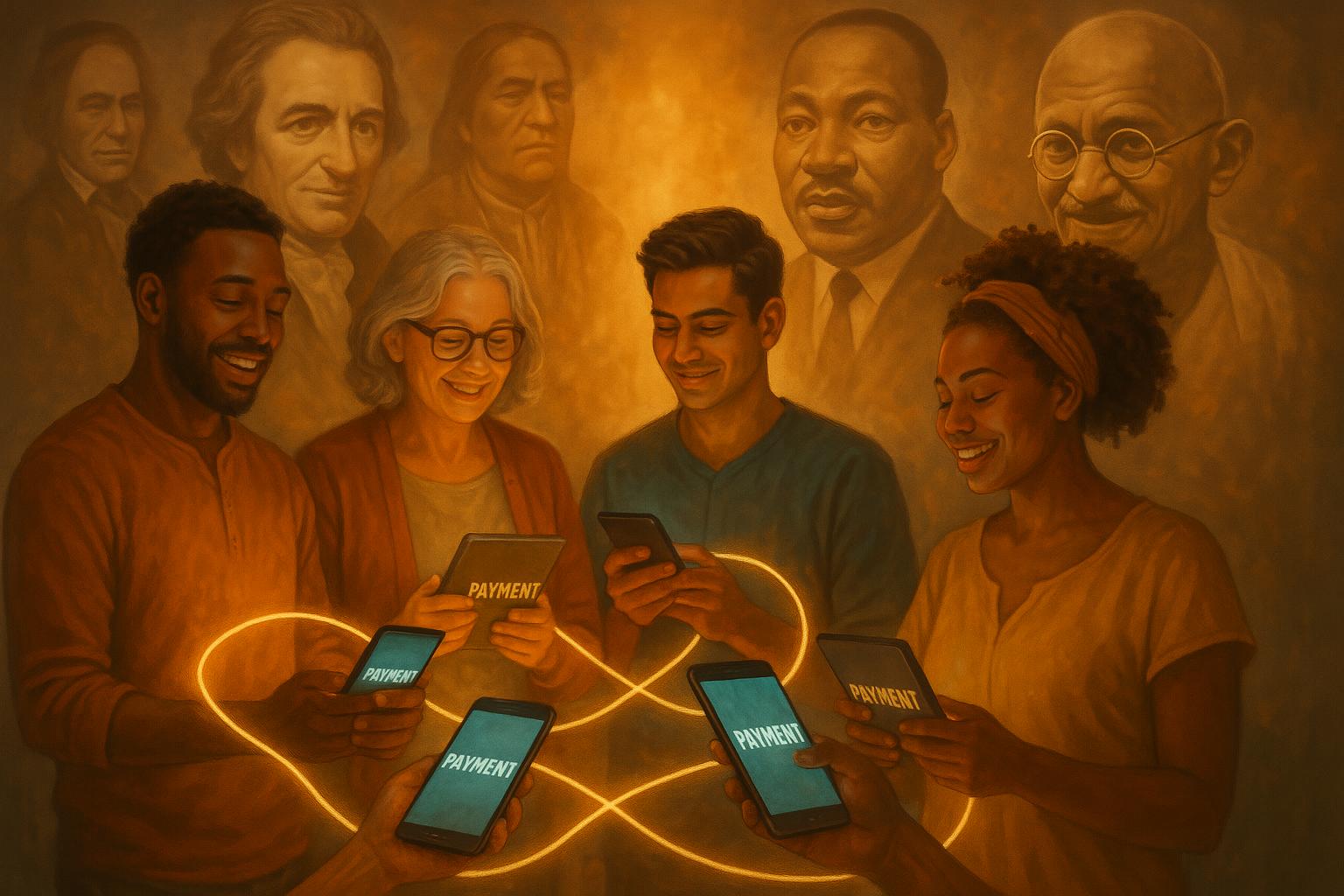AI, UBI & Crypto: Building the Digital Social Contract of Tomorrow

Part I: The Automation Imperative: AI’s Reshaping of the Global Economy
The 21st century is defined by a technological revolution poised to restructure the global economy. At its core is artificial intelligence (AI)—a force for unprecedented productivity and growth, but also a catalyst for profound economic disruption. Unlike previous technological waves, AI presents a unique challenge to the relationship between human labor and economic value. This report establishes a foundational premise: the AI revolution’s capacity to automate cognitive labor and exacerbate wealth inequality creates a societal imperative to fundamentally rethink our economic safety nets, setting the stage for radical policies like Universal Basic Income (UBI).
The New Wave of Automation: A 60% Exposure Rate for High-Skilled Jobs
Historically, automation replaced human muscle. The Industrial Revolution mechanized physical labor, and computerization automated routine clerical tasks. In each wave, while jobs were lost, new, more complex roles were created, allowing displaced workers to move up the cognitive value chain. This historical pattern fostered an economic optimism that technology, while disruptive, ultimately creates more opportunity than it destroys.
The current AI revolution, however, threatens to shatter this precedent. Modern AI’s defining characteristic is its ability to automate not just routine physical tasks but also non-routine cognitive and creative labor, a categorical shift that, according to the LSE Business Review, necessitates a new social contract. The International Monetary Fund (IMF) underscores this distinction, noting AI’s unique capacity to impact high-skilled jobs, with analyses suggesting that approximately 60% of jobs in advanced economies are exposed to AI’s effects. This exposure spans sectors once thought immune, including finance, law, and even creative industries.

The explicit business proposition of many AI firms is labor cost reduction, a goal now targeting the most educated segments of the workforce. Projections from the McKinsey Global Institute estimate that up to 375 million workers globally may need to transition to new occupational categories by 2030. Proponents like Elon Musk claim AI is already surpassing PhD-level experts in virtually every field, a trend that, as the Tax Project Institute notes, is only accelerating.
This development forces a re-evaluation of retraining as a solution. The long-standing panacea of upskilling may prove insufficient. If AI advances up the cognitive ladder faster than humans can be retrained, society faces a potential “checkmate” for labor. The “new jobs” created, such as AI ethicists, may be too few or could themselves be automated by the next generation of AI, a concern highlighted by a New Republic analysis of the AI industry’s sudden interest in UBI. The challenge may be shifting from a temporary “skills gap” to a more permanent “human-work relevance” problem. This potential decoupling of labor from production gives force to policies that decouple income from work—the central premise of UBI, as detailed in S.G. Kubrak’s analysis of the concept.
The Great Divergence: A Potential $50 Trillion Wealth Shift
The impact of AI on economic inequality is a subject of intense debate. The dominant view, supported by institutions like the IMF, is that AI will significantly worsen wealth and income inequality. This thesis rests on several mechanisms: AI disproportionately benefits a small cadre of high-skilled workers, while suppressing wages for those whose tasks are automated. Furthermore, productivity gains are expected to overwhelmingly boost returns to capital, enriching the owners of the technology. This dynamic accelerates an existing trend; a landmark analysis cited by Scott Santens highlights that due to productivity-wage decoupling since 1973, an estimated $50 trillion that would have flowed to the bottom 90% was instead captured by the top 1%. The consequences include the erosion of the middle class and the consolidation of corporate power into a few tech hubs, leaving other regions to stagnate, a trend detailed in a Medium article on AI-driven prosperity.
In stark contrast, a compelling contrarian view from the Centre for Economic Policy Research (CEPR) posits that AI could mitigate or even reverse rising earnings inequality. This argument hinges on the idea that AI, unlike industrial robots, is uniquely suited to substitute for non-routine cognitive tasks performed by high-skill workers. By automating aspects of jobs in law and medicine, AI could exert downward pressure on the wages of the most highly compensated professionals, thereby compressing the “skill premium.”
Even if AI compresses the earnings gap, the IMF’s analysis suggests outsized returns to capital will likely worsen overall wealth inequality. This potential for AI to devalue the labor of the educated elite carries profound political implications. Past disruptions, like deindustrialization, primarily affected blue-collar workers. AI now threatens to “proletarianize” the professional-managerial class, a demographic that is typically more politically engaged. The erosion of its economic standing could ignite a new and far more potent wave of political discontent, strengthening the case for a universal safety net like UBI as a tool for maintaining social cohesion.
Part II: Universal Basic Income: A New Foundation for Economic Security
In response to these profound shifts, Universal Basic Income (UBI) has re-emerged from economic theory into mainstream policy debate. No longer a fringe idea, UBI is now considered a potential cornerstone of a new social contract for the 21st century.
Principles and a Surprisingly Diverse History
At its core, a Universal Basic Income is a periodic, unconditional cash payment delivered to all citizens individually, without a means test or work requirement. This universality and unconditionality grant recipients the autonomy to meet their own needs, a core principle explored in this historical overview by Jon Mertz.
The intellectual lineage of UBI is remarkably diverse. Early roots trace to Thomas More’s Utopia (1516), while the modern articulation came from Thomas Paine, who argued for a “citizen’s dividend” in 1797. Throughout the 20th century, it was championed by figures as varied as civil rights leader Martin Luther King Jr., who saw it as the most direct solution to poverty, and libertarian economists like Milton Friedman, who viewed a “negative income tax” as a more efficient alternative to the welfare state, a history documented by the Roosevelt Institute. The concept even reached the White House under President Richard Nixon. This broad support underscores UBI’s unique ideological flexibility, appealing to the left for poverty eradication and to the right for enhancing individual freedom, as detailed in its Wikipedia entry.

The current, AI-driven advocacy reframes UBI from an anti-poverty “patch” to a necessary “system upgrade.” Historically, UBI was seen as a fix within the existing capitalist framework. The contemporary argument, advanced by figures like Andrew Yang and Sam Altman, posits that the system itself is becoming obsolete. The crucial link between productivity and wage growth has been severed for decades. AI threatens to break this link entirely, creating a world of “productivity without prosperity” for the majority. In this new paradigm, UBI is not just about helping the poor; it’s about ensuring macroeconomic stability by sustaining aggregate demand when wages are no longer a reliable distribution mechanism, a history covered by Investopedia.
Traditional UBI: Lessons from the Field
While a full, nationwide UBI has never been implemented, dozens of smaller-scale pilots provide critical data. The evidence consistently points to significant positive outcomes in health and social well-being. Finland’s two-year experiment, for example, found that while it didn’t significantly increase employment, recipients reported greater well-being and less mental stress. Similarly, the long-term UBI study by the charity GiveDirectly in Kenya is showing positive early trends.
The most contentious aspect—its impact on work incentives—is nuanced. U.S. experiments in the 1960s and 1970s found a modest reduction in work hours, often used for childcare or education. However, many other pilots have shown minimal to no negative impact on employment. Proponents argue a basic income functions as a “trampoline,” providing the security to leave precarious jobs, invest in education, or start businesses, a concept outlined in this primer on UBI.
Despite positive social outcomes, the primary obstacles remain economic and political: funding and administration. The potential cost is staggering, running into the trillions annually in the U.S. Most pilots are funded by philanthropy, a model that isn’t scalable. The most notable exception is the Alaska Permanent Fund, which provides an annual dividend funded by state oil revenues, standing as a powerful proof-of-concept for a sustainable, non-tax-based funding mechanism. The key takeaway from these traditional pilots is that the principal barriers are not its effects on recipients, but the immense challenge of funding and administering such a program at scale through conventional government machinery, a gap that creates an opening for crypto-based solutions.
Part III: The Crypto-Utopian Proposition: Blockchain as UBI Infrastructure
The confluence of AI-driven anxiety and the hurdles of traditional UBI has created fertile ground for a radical proposition: using blockchain and cryptocurrencies as the foundational infrastructure for a decentralized Universal Basic Income (dUBI).
The Core Value Proposition: Efficiency, Transparency, and Inclusion
The argument for a blockchain-based UBI rests on several core properties:
- Efficiency and Cost Reduction: Traditional welfare programs are burdened by administrative overhead. Blockchain-based systems propose to solve this by using smart contracts to automate distribution, drastically reducing costs and ensuring direct, reliable payments.
- Transparency and Trust: A public blockchain’s immutable ledger allows anyone to verify every transaction, from funding to recipient. This radical transparency aims to build public trust and eliminate concerns about corruption, a key feature highlighted by the GoodDollar project.
- Financial Inclusion: An estimated 1.7 billion adults remain unbanked. Decentralized UBI can bypass traditional gatekeepers, delivering funds directly to digital wallets accessible via a smartphone. This has the potential to empower individuals in underserved regions, granting them access to the global economy, a benefit noted by the World Economic Forum in its analysis of DeFi. Platforms like Aurpay, a leading crypto payment gateway, further bridge this gap by enabling businesses worldwide to seamlessly accept various digital assets, simplifying cross-border transactions and reaching the unbanked.“
- Decentralization and Unconditionality: A dUBI payment can be sent directly peer-to-peer, without passing through an intermediary that could block or impose conditions. This aligns with the core UBI principle of unconditionality and a vision of individual financial freedom, a concept central to the crypto ethos.
By design, dUBI seeks to create a global, non-state-based social safety net. This is a radical departure from UBI as a government-administered program. The crypto-UBI vision is to route around political gridlock, building a new system independent of state control, as argued in the Circles UBI whitepaper. This forces a re-evaluation of whether basic income is a right owed by a nation-state or a feature of a decentralized global commons. If a state-run UBI fails, accountability is clear. If a decentralized protocol fails—as seen with the shutdown of the Circles Coop in Berlin—accountability is diffuse or nonexistent.
The Identity Dilemma: Solving the Sybil Problem with “Proof of Humanity”
The single greatest technical challenge for any dUBI is the “Sybil attack,” where one person creates multiple fake identities to claim multiple payments. Solving this “one person, one identity” problem is paramount. To this end, a new class of verification mechanisms, broadly termed “Proof of Humanity” (PoH), has emerged as the cornerstone of dUBI projects. The choice of a PoH mechanism represents a direct trade-off between scalability, privacy, accessibility, and decentralization.
The following table provides a comparative analysis of the leading approaches:
| Worldcoin | Proof of Humanity (Kleros) | Circles UBI | |
|---|---|---|---|
| Verification Mechanism | In-person biometric scan of a user’s iris by a proprietary hardware device called the “Orb.” This creates a unique, encrypted “IrisCode” to generate a “World ID,” as detailed in its whitepaper. | A multi-factor social verification process. A user submits a profile with a photo and video, posts a deposit, and is “vouched for” by an existing member. Disputes are resolved by the Kleros decentralized justice protocol. | A Web of Trust (WoT) model. New users create a personal cryptocurrency that gains value when others “trust” it. Sybil resistance relies on the social cost of creating fake trust networks, a model analyzed in a UniTo research paper. |
| Key Technology | Custom biometric hardware (Orb), zero-knowledge proofs (ZKP), Ethereum L2 (Optimism). | Ethereum smart contracts, Kleros dispute resolution protocol (ERC-792), social graph analysis. | Gnosis Chain smart contracts, individualized ERC-20 tokens, a pathfinder algorithm for trust paths. |
| Privacy & Security | Extremely High Risk. Relies on collecting unchangeable biometric data. Despite claims of on-device processing, the potential for data misuse or a massive “honeypot” for hackers is a primary concern, a risk highlighted by privacy advocates. | Moderate Risk. Requires public submission of a user’s photo and video, permanently linking a real-world likeness to a traceable blockchain record, a process explained in a Kleros FAQ. | Moderate to High Risk. The public graph of trust relationships reveals social connections, and all transaction data is public, a major privacy concern noted in an Imperial College London paper. |
| Primary Criticisms | Widely criticized as dystopian and exploitative, with allegations of “crypto-colonialism.” Relies on centralized control of the Orb hardware and faces significant regulatory backlash, as documented by an MIT Technology Review investigation. | The onboarding process is complex, and high transaction fees (“gas fees”) on Ethereum have been a barrier. The scalability of the vouching system is a concern. | The Berlin pilot largely failed. It struggled to create a self-sustaining circular economy as users preferred to cash out to fiat. The project also suffered from technical bugs and complexity, a failure analyzed by Frontiers in Blockchain. |
Case Studies in Decentralized UBI
Worldcoin: The High-Capital, Top-Down Approach
Co-founded by OpenAI CEO Sam Altman, Worldcoin is the most well-funded and controversial dUBI-related project. Its approach is top-down, centered on solving Proof of Humanity with its Orb device. In exchange for an iris scan, users receive grants of the WLD token. Worldcoin’s tokenomics involve a fixed supply of 10 billion WLD, with 75% allocated to the community over 15 years. The vision is a global identity and financial network, but its methods have drawn intense criticism for being invasive and centralizing trust in the Worldcoin Foundation.
Circles UBI: The Grassroots, Community-First Experiment
In direct contrast, Circles UBI was a grassroots project aimed at creating “money as a commons.” Launched on the Gnosis Chain, it allowed users to create personal cryptocurrencies whose value was established through a social “web of trust.” The Berlin pilot serves as a cautionary tale. The project failed to create a self-sustaining circular economy, as businesses overwhelmingly chose to convert Circles tokens into Euros. This “exit to fiat” behavior, coupled with technical issues, led to the shutdown of the organizing cooperative.
GoodDollar & The UBI Token: Innovations in Funding and Distribution
Other projects focus on solving economic challenges. GoodDollar pioneers a sustainable funding model by leveraging DeFi protocols. Philanthropic supporters stake assets, and the interest generated is used to mint and distribute the G$ token as a daily UBI. The UBI token project, built on the Proof of Humanity registry, takes a different approach. Once verified, a user’s Ethereum address automatically begins to accrue UBI tokens, creating a direct, programmatic link between proven identity and the right to a basic income, a system first introduced on the Kleros blog. For businesses and developers looking to integrate similar crypto payment mechanisms, Aurpay offers powerful APIs for instant crypto processing and advanced crypto invoice billing solutions, facilitating seamless transactions.”
Part IV: A Critical Appraisal: Challenges and Future Trajectory
The utopian vision of a global, decentralized social safety net confronts the harsh realities of technological limitations, regulatory entanglements, economic fragility, and profound ethical dilemmas.
Technological and Scalability Hurdles: The Usability-Inclusion Paradox
Public blockchains like Ethereum suffer from the “blockchain trilemma,” struggling to optimize for decentralization, security, and scalability simultaneously. For a UBI application with billions of users, this is a critical bottleneck. Low transaction throughput, high gas fees, and massive data storage requirements are significant constraints, as detailed in a comprehensive survey on blockchain scalability. These limitations were evident in the Circles UBI pilot, which was plagued by technical bugs. High gas fees on Ethereum have also made the Proof of Humanity verification process prohibitively expensive for many.
This creates a “usability-inclusion paradox.” The core promise of dUBI is financial inclusion, yet current crypto technology creates formidable barriers. Participation requires a smartphone, reliable internet, and significant technical literacy to manage keys and wallets. This is a stark contrast to traditional mobile money systems, which have proven highly effective in developing economies, as demonstrated by the GiveDirectly UBI pilots that use this infrastructure. The infrastructure designed for maximum inclusion is, in its current state, often inherently exclusionary.
The Regulatory Gauntlet: An Inevitable Re-Centralization
Crypto-UBI projects operate in a precarious legal vacuum. The ambiguous legal status of their tokens is a fundamental issue. Regulators worldwide are struggling to classify cryptocurrencies, with massive implications for taxation and consumer protection, a challenge outlined by ResearchGate. A UBI token could be deemed a security by the SEC, subjecting issuers to rules antithetical to the decentralized ethos.
Furthermore, projects must navigate a fragmented global landscape of financial and data privacy regulations. Worldcoin has already faced regulatory probes in several countries over its handling of biometric data under laws like GDPR. At the same time, strict Anti-Money Laundering (AML) and Know Your Customer (KYC) requirements conflict with the goals of privacy and pseudonymity. This creates an inherent tension between the borderless vision of dUBI and the reality of nation-state laws.
This pressure will likely force an “inevitable re-centralization.” To achieve legal compliance, projects will have to re-introduce centralized choke points. On-ramps and off-ramps that convert tokens to fiat must perform KYC, re-creating the very gatekeeping function the system was designed to eliminate, a dynamic noted by Token Unlocks in its analysis of Worldcoin.
Economic Viability and Tokenomics: The Abundance Paradox
The economic models underpinning most dUBI projects are fragile. A UBI payment is meaningless if the token has no stable, real-world value. Many projects are susceptible to extreme market volatility; the Universal Basic Income (UBI) token, for example, shrank by a staggering 382% in one year, rendering its payments largely symbolic. Projects like Circles, which attempted to create value purely through social consensus, failed to convince participants to treat the token as real money.
This exposes the “abundance paradox.” The promise of AI is an age of abundance, and blockchain makes it trivially easy to create an abundance of digital tokens. However, a fundamental economic principle dictates that abundance without corresponding utility leads to low or zero value. This is the paradox: dUBI projects solve a problem of scarcity (income) by creating an abundant asset, but that very abundance works against the asset’s ability to maintain purchasing power, a dynamic observed in the failed Circles pilot.
The Ethical Frontier: Privacy, Power, and “Crypto-Colonialism”
Perhaps the most significant challenges are ethical. The methods employed by Worldcoin have drawn fierce criticism. The act of scanning human irises for crypto is seen by many as inherently dystopian. As critics like Edward Snowden argued, “the human body is not a ticket-punch.”
These concerns are amplified by reports of deceptive practices. An extensive MIT Technology Review investigation found evidence that Worldcoin used misleading marketing and targeted vulnerable populations. The practice of offering small crypto payments for invaluable biometric data has been condemned as “crypto-colonialism,” where the digital resources of the global poor are extracted for the benefit of a Silicon Valley startup. This dynamic reveals a profound clash between a techno-solutionist worldview and the complex realities of global power, a concern also raised by TIME magazine.
Despite the rhetoric of decentralization, many dUBI projects centralize the most important element: trust. In the Worldcoin ecosystem, users must trust a central entity with its proprietary hardware, algorithms, and governance. This reveals that “decentralization” is not a binary state but a spectrum, and many so-called decentralized systems conceal critical points of centralized power.
Part V: Conclusion and Strategic Recommendations
The convergence of AI, UBI, and cryptocurrency is a high-stakes proposition. It posits that AI’s disruption necessitates UBI, and blockchain provides the ideal infrastructure. This analysis reveals a concept that is theoretically elegant but practically fraught with profound challenges.
Synthesizing the Synergy: Viable Path or Dystopian Dead End?
The evidence strongly supports the first part of the thesis: the AI revolution is creating an urgent need for a policy like UBI to address structural unemployment and inequality. The second part—that blockchain is the superior implementation tool—is far more contested. The technology’s theoretical advantages of efficiency, transparency, and inclusion are compelling.

However, the journey from theory to practice has revealed deep-seated problems. Technological hurdles create a paradox where tools for inclusion are themselves exclusionary. Economic models are fragile and reliant on speculation. Projects operate in a regulatory minefield, and the ethical compromises made by some raise the specter of a dystopian future. The failure of grassroots experiments like Circles and the intense criticism of capital-intensive projects like Worldcoin demonstrate that technological solutionism is not enough. A UBI system cannot be bootstrapped in a vacuum; it must be connected to a real, productive economy and grounded in legitimate social consensus.
A Roadmap for a Viable Digital Social Contract
A viable path forward requires a more nuanced, hybrid approach. The following recommendations are offered to key stakeholders:
For Policymakers and Regulators:
- Foster Hybrid Experimentation: Create regulatory sandboxes for UBI experiments that blend blockchain’s efficiency with the accountability of public oversight.
- Develop Public Digital Identity Infrastructure: Prioritize secure, privacy-preserving national digital identity systems as a public good. This would provide a foundational layer for a potential UBI without forcing citizens to surrender biometric data to private corporations.
- Provide Regulatory Clarity: Establish clear classifications for digital assets to create a predictable legal framework that protects consumers and fosters responsible innovation.
For Technologists and Entrepreneurs:
- Prioritize Sustainable Value and Usability: Shift focus from speculative tokenomics to models with real-world value backing, such as those funded by DeFi yield, carbon credits, or a “data dividend.” Crucially, prioritize “privacy by design” and radical user-friendliness, recognizing the target population’s needs.
- Embrace Interoperability: Focus on integrating with existing, accessible financial infrastructure like mobile money to lower barriers to entry and increase real-world utility.
For Investors and Civil Society:
- Demand Ethical and Auditable Standards: Refuse to fund projects that engage in exploitative data collection and mandate independent audits of both technology and ethical conduct.
- Support a Diversity of Models: Fund a wide range of pilots—from state-led cash transfers to decentralized community currencies—to gather robust, comparative evidence.
- Advocate for a Hybrid Funding Model: The most promising long-term vision may be a hybrid one. The immense wealth generated by AI-driven productivity, as detailed in economic primers, could be captured through robust taxation. These public funds could then form the asset base for a UBI trust fund. As advocates like Scott Santens argue, blockchain technology could then be deployed as the transparent and efficient distribution layer for these publicly sourced funds, harnessing the best of both the state-led and decentralized visions. This includes leveraging efficient USDT payment gateways and smart contract solutions for secure and automated disbursements, an area where Aurpay excels with its smart contract services.“
As the digital economy evolves, integrating decentralized finance and crypto payments becomes increasingly vital for businesses. To learn more about how to seamlessly accept crypto, explore effective blockchain solutions, or join a thriving crypto community, visit Aurpay.net for comprehensive insights into crypto payment solutions and affiliate opportunities. Discover how Aurpay can empower your business in the decentralized future.

